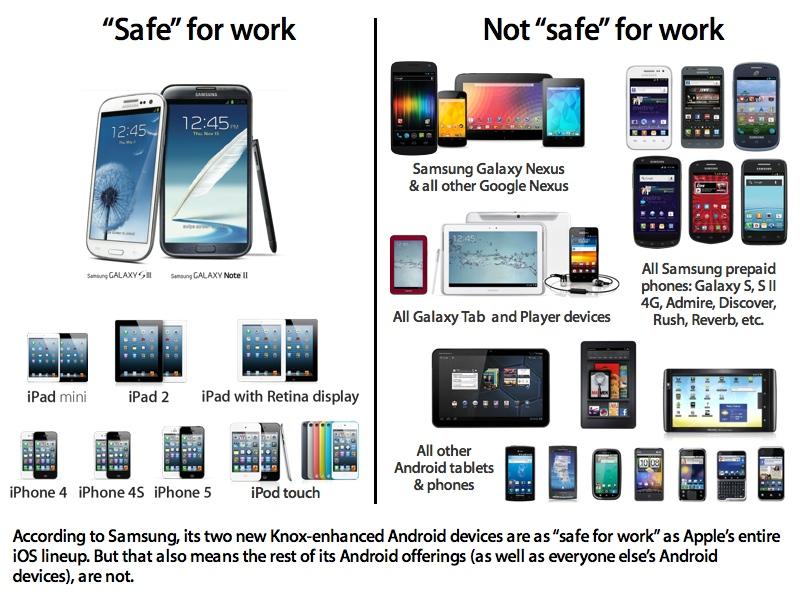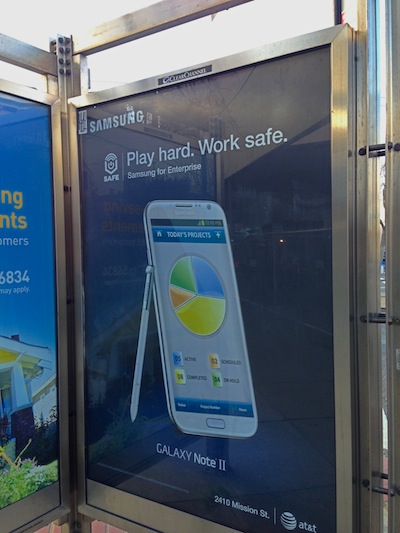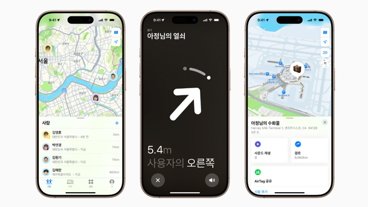Samsung's Knox security layer for Android generates weak encryption keys, stores passwords locally and gives users login hints in a fatal "security by obscurity" design "compromising the security of the product completely," a researcher has detailed.
[ Update: Samsung has responded in a statement on its Knox blog, writing, "we analyzed these claims in detail and found the conclusions to be incorrect for KNOX enterprise solutions," detailing that "KNOX enterprise containers do not store any alternative PIN for password recovery purposes," and explaining that the practice of saving a user's PIN in clear text in order to supply the user with a password hint was limited to "KNOX 1.0's Personal containers, designed to let consumers experience the KNOX container."
The company maintains that "Samsung KNOX devices have received multiple security certifications such as FIPS 140-2 and MDFPP, which serve as evidence by trusted third parties that Samsung has done it right."
However, a series of products that have received security certifications such as FIPS 140-2 (including Apple's devices running iOS 6, select Samsung Galaxy phones running Android and Knox, and BlackBerry OS 10 products) were later found to have serious flaws, including Apple's GotoFail SSL flaw patched in iOS 7.0.6; Blackberry OS 10 vulnerabilities tied to Flash and Heartbleed, and a series of Android and Knox related flaws including Fake ID.]
Samsung ships its Knox software on the company's higher-end Android-based Galaxy smartphones, phablets and tablets, aimed at enabling sales to enterprise and government clients who have sensitive security needs, in a bid to take on Apple's extensive lead in enterprise sales.
Two days ago, Samsung announced that the U.S. government had approved a series of new devices "for use with classified government networks and data. All devices and capabilities incorporate security features powered by Samsung KNOX," and were added to the "Commercial Solutions for Classified (CSfC) Program Component List."
The company's chief executive JK Shin stated in a press release that "the inclusion of Samsung mobile devices on the CSfC list proves the unmatched security of Samsung Galaxy devices supported by the KNOX platform."
Jacob Kleinman, writing for TechnoBuffalo, stated that "it looks like Samsung's hard work developing its Knox security software is paying off," while Jennifer Baker of the UK site The Register reported, "U.S. spooks will be allowed to access sensitive government information on their KNOX-locked Samsung gadgets from now on. The South Korean company has been heavily pushing its new KNOX security product and it looks as though its efforts have paid off."
Wait, stop, come back
Earlier today, however, a software researcher published findings showing that Samsung's Knox app stores the user's password "hint" PIN in plain text on the device.Samsung Knox users log into the Knox app using a password and PIN, which is then written into a "pin.xml" file in cleartext.
The Knox app establishes a "Knox Container" with its own home screen for launching secured apps, which do not mingle with the user's own private apps and data. This design attempts to work around the wide open design of Android, which has no effective app security, much like an iOS device that has been jailbroken.
However, Samsung Knox users log into the Knox app using a password and PIN, which is then written into a "pin.xml" file in cleartext, available to anyone looking at the file system. The user (or anyone else who reads the cleartext PIN) can enter the PIN to gain a "password forgotten?" hint.
As the research describes, upon entering the PIN, "the Knox app will show you a little password hint (the first and the last character of your password!! + the original length of your password!)"
This "hangman game" style password security is not the extent of the problem.
"It is pretty obvious that Samsung Knox is going to store your password somewhere on the device," the researcher noted, further detailing that "in the Folder /data/system/container there is a file called containerpassword_1.key," which stores the user's encryption key.
Samsung Knox 'compromised completely'
The research further examined Samsung Knox, looking for "how exactly the encryption of the password works and where the key for the encryption comes from."
The article noted, "Samsung makes use of dex-preoptimization to strip out all classes.dex files (the java code is stored in a file called classes.dex and this file is parsed by the Dalvik JVM) in the Knox apks, thus making reverse engineering a little bit harder. To get the binaries we have to look at /system/app/ and find .odex files (an odex is basically a pre-processed version of an application's classes.dex that is execution-ready for Dalvik). odex files can be converted back into smali code, which then can be converted back to a dex file. Finally a dex file can be converted into a jar file, which can be decompiled by any Java Decompiler. "the fact that they are persisting the key just for the password hint functionality is compromising the security of that product completely"
"Samsung didn't make any use of code obfuscation but really tried to hide the password storage code within hundreds of java classes, inheritance and proxies."
What he ultimately discovered was that Knox simply uses the device's Android ID, a serial number any app can request from the system, "together with a hardcoded string and mix them for the encryption key. I would have expected from a product, called Knox, a different approach."
He further points out, "the fact that they are persisting the key just for the password hint functionality is compromising the security of that product completely. For such a product the password should never be stored on the device." In conclusion he recommends, "Instead of Samsung Knox, use the built-in Android encryption function and encrypt the whole device."
Fortunately, few are actually trying to use Knox
Samsung first unveiled Knox in early 2013 as part of an effort to add "fundamental security and management enhancements" in order "to address the shortcomings of the current open source Android platform."
Before Knox was even available, Samsung immediately began advertising it as part of its "SAFE" initiative (short for "SAmsung For Enterprise") via billboards portraying Samsung devices running mockups of business presentation and project management software that doesn't really exist.
Shortly after Knox was first introduced on the Galaxy Note 3 last year, Mordechai Guri, a researcher at Ben-Gurion University's Cyber Security Lab described a vulnerability that he detailed would "would allow a hacker to 'easily intercept' secure data of a user of a Knox-enabled Galaxy smartphone."Of the 87 million devices that shipped with Knox, only 1.8 million were actually using it
In a worst-case scenario, Guri stated, "a hacker could modify data and even insert hostile code that could run amok within the secured network."
Six months later, the Wall Street Journal described the issue as "a possible security gap" and said that Samsung had "clarified" that the issue "is not specific to Samsung devices."
This May, however, Samsung executive Rhee In-jong, appearing in another Wall Street Journal article— which sought to distract attention away from Apple's Touch ID fingerprint sensor by talking about vaporware plans for "iris scanning" biometrics— noted that of the 87 million devices that shipped with Knox, only 1.8 million were actually using it: only about 2 percent.
Android 5.0 Lollypop gets Knoxed up
In June, Google's head of Android development Sundar Pichai announced plans for Android 5.0 "Lollypop," with a security layer for enterprise users provided by Samsung's "contribution" of Knox.
The shotgun wedding of Lollypop and Knox appeared to be a compromise between Google and Samsung, which— according to a report by The Information— had been involved in a tense standoff since January, when Samsung demonstrated its own new user interface dubbed "Magazine UX," which Pichai viewed as a direct threat to Google's control over and monetization of Android.
Pichai was reportedly "prepared to forbid" Samsung from using the ostensibly open Android operating system unless it fell into line with Google's requirements. That demand makes more sense given Google's announcements of a second attempt at delivering its own cohesive user interface for Android, an web-inspired initiative it calls "Material Design."
The standoff also explains how Samsung could be strong-armed into "contributing" Knox, a significantly differentiating feature that has made some of Samsung's products at least possible for government and corporate users to buy, while other Android vendors have been virtually shut out of the enterprise entirely, as alluded to by IDC's Mobility Research Director Ryan Reith.
Knox was a differentaitor for Samsung in enterprise...'was' being key word. Why would they let that go??
— Ryan Reith (@ryanreith) June 25, 2014After Google introduced Knox as its solution for securing Android in June, Bluebox Security detailed severe new flaws in Android itself, tied to the fact that the operating system simply failed to verify apps' cryptographic signatures, essentially allowing any app— even one given no special access permissions— to falsely pass itself off as a trusted app and gain extensive control over the user's apps and data.
The "Fake ID" vulnerability can exploit Android's webview, infecting a wide variety of third party apps that incorporate it, and can also target trusted Google software including its broadly installed NFC Wallet app or remnants of the 3LM device management tool, which appears on a wide variety of Android phones from HTC, Pantech, Sharp, Sony Ericsson, and Motorola.Apple has seized upon Android's security and privacy problems to emphasize that iOS is designed "with security at its core."
The majority of Android devices making up the platform's "80 percent share" of smartphones globally have still not been updated to fix the Fake ID flaw. Additionally, while Google has made efforts to scan Google Play apps for malicious code, a variety of app stores operating overseas— including in China, where Google maintains little control over Android— have not.
Earlier this year, Pichai outlined Google's a very different approach to security in Android, staying, "we do not guarantee that Android is designed to be safe; its format was designed to give more freedom. When they talk about 90% of malicious programs for Android, they must of course take into account the fact that it is the most used operating system in the world. If I had a company dedicated to malware, I would also send my attacks to Android."
Apple has seized upon Android's security and privacy problems to emphasize that iOS is designed "with security at its core."
In a white paper detailing the security of iOS— including Touch ID and the Secure Enclave of its latest 64-bit Application Processors— the company stated, "when we set out to create the best possible mobile OS, we drew from decades of experience to build an entirely new architecture. We thought about the security hazards of the desktop environment, and established a new approach to security in the design of iOS. We developed and incorporated innovative features that tighten mobile security and protect the entire system by default. As a result, iOS is a major leap forward in OS security."
 Daniel Eran Dilger
Daniel Eran Dilger







-xl-m.jpg)


-m.jpg)






 Chip Loder
Chip Loder
 Thomas Sibilly
Thomas Sibilly
 Wesley Hilliard
Wesley Hilliard
 Christine McKee
Christine McKee
 Amber Neely
Amber Neely
 William Gallagher
William Gallagher
 Malcolm Owen
Malcolm Owen









72 Comments
don't they have a team of over 250 people on this? (just on Knox) If this is the case, they have poor or non existent processes and methods.
My guess is that some folks at NSA and DISA will be looking for jobs. Or at least some serious re-training time. This is a fiasco of the first order for them.
I wonder which senators will publicly demand for Samsung to respond?¡
Instead of using the name Knox, presumably based on Fort Knox, Scamsung should have used Fort Courage as their inspiration, you know, the home of F Troop. That was a farce too.